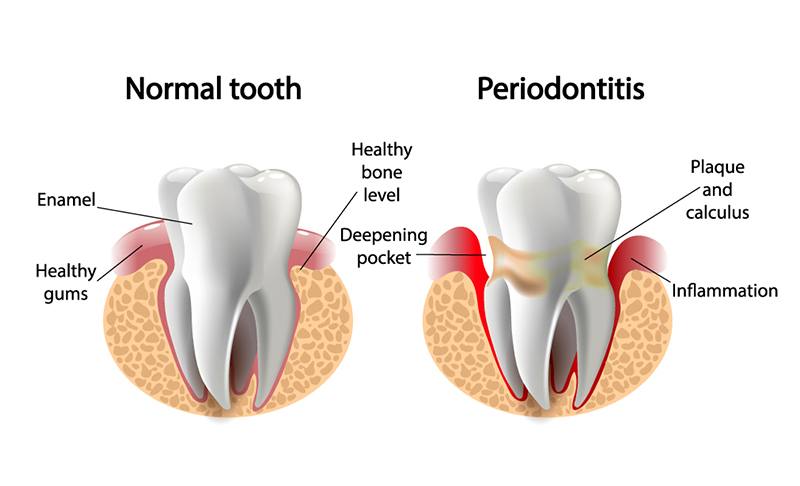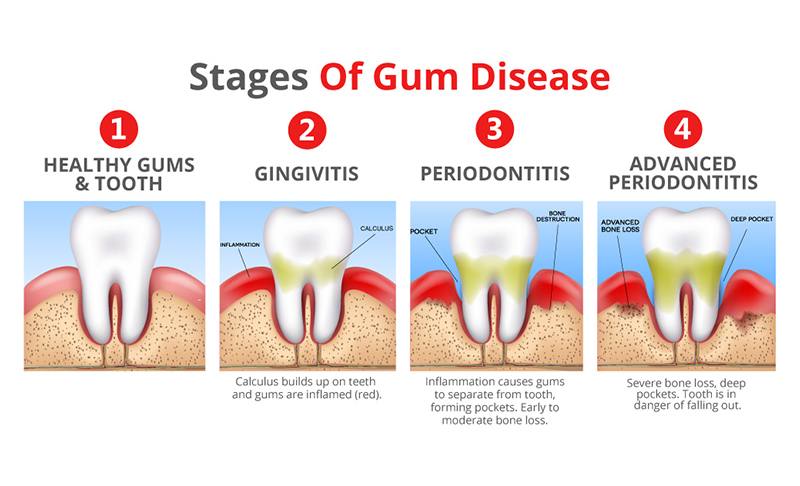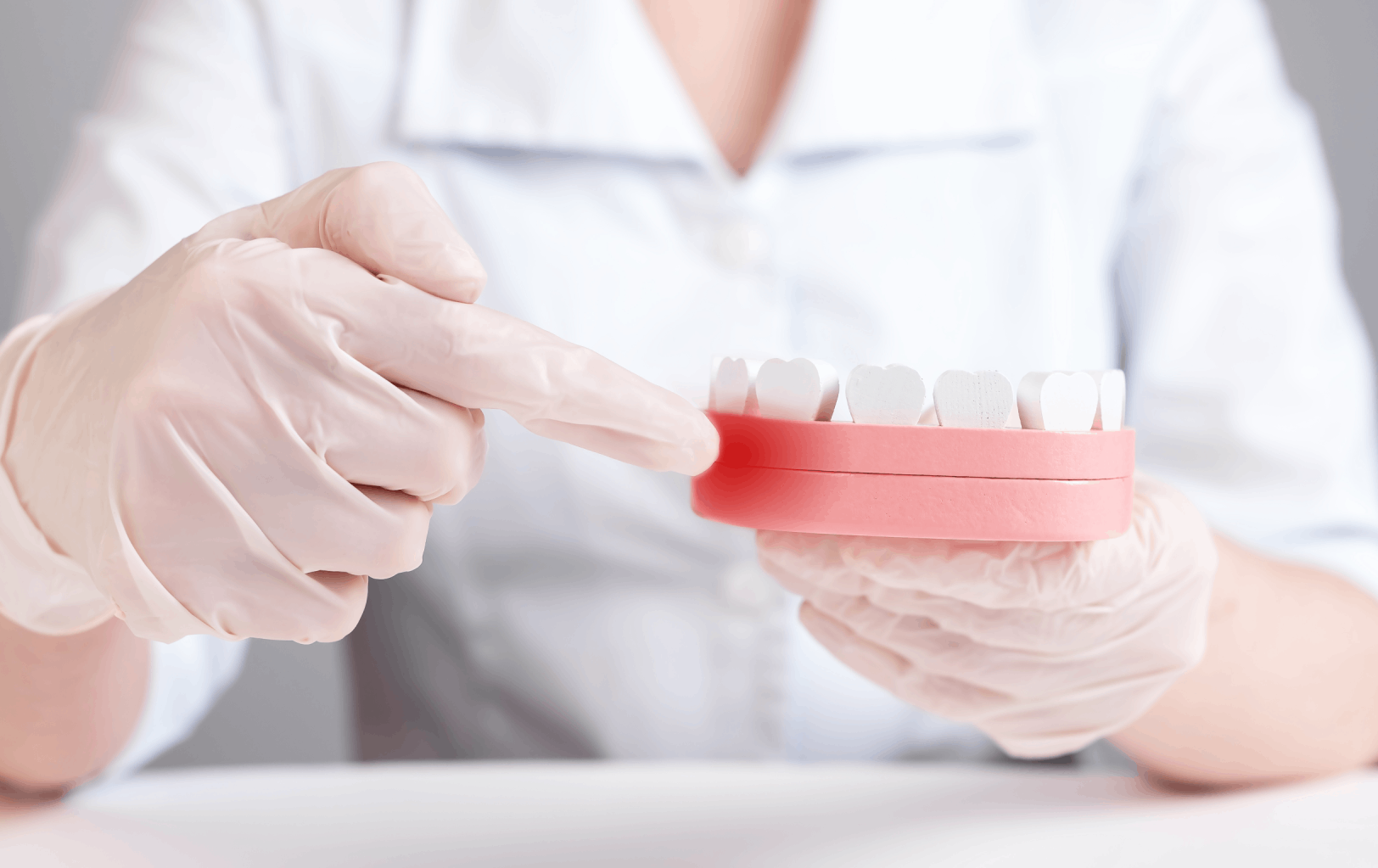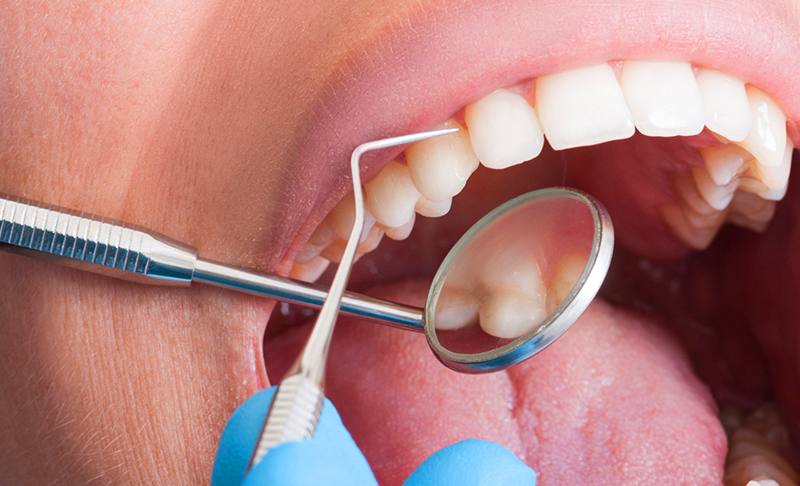WHAT IS PERIODONTAL DISEASE?
Periodontal diseases are infections of the gums, which gradually destroy the support of your natural teeth. There are numerous disease entities requiring different treatment approaches. Dental plaque is the primary cause of gum disease in genetically susceptible individuals. Daily brushing and flossing will prevent most periodontal conditions.
Periodontal diseases can be accelerated by a number of different factors. However, it is mainly caused by the bacteria found in dental plaque, a sticky colorless film that constantly forms on your teeth. If not carefully removed by daily brushing and flossing, plaque hardens into a rough, porous substance known as calculus (or tartar).
CAUSES OF GUM DISEASE

CAUSES OF GUM DISEASE
Bacteria found in plaque produces toxins or poisons that irritate the gums, which may cause them to turn red, swell and bleed easily. If this irritation is prolonged, the gums separate from the teeth, causing pockets (spaces) to form. As periodontal diseases progress, the supporting gum tissue and bone that holds teeth in place deteriorate. If left untreated, this leads to tooth loss.
SCALING AND ROOT PLANING

HOW DO WE PREVENT GUM DISEASE?
Many times, the early stages of periodontal disease are best treated with non-surgical periodontal therapy. Even in severe cases of periodontal disease, non-surgical periodontal therapy often precedes surgical therapy. This is done to improve the overall tissue quality prior to surgery and also to help limit the areas requiring surgery. These procedures are a predictable way to cover unsightly, sensitive or exposed root surfaces and to prevent future gum recession. If you are unhappy with the appearance of short unsightly teeth this can be greatly improved by a combination of periodontal procedures by our periodontist and cosmetic dentistry by our dentist.
GETTING STARTED :
GUM DISEASE
STEP 1
Find a certified Periodontist.
STEP 2
Start periodontal treatment.
STEP 3
Attend follow-ups as instructed by Periodontist.
ROOT PLANNING PROCEDURE
- Deep and detailed scaling of the root surface to decrease inflammation of the gum tissue. The dentist will aim to smooth out rough target areas, eliminating plaque. This step must be repeated several times.
- After about 4-6 weeks of treatment, the dentist will call back to see the symptoms again, whether it is well or not, if there are still periodontal trenches or dissolution of the bone. Periodontal surgery may be required.
- Excellent oral health must be maintained. Daily brush and flossing in order to prevent plaque is beneficial.
- Visit a dentist every six months to see if there are major plaque residues build-ups after the cleansing process in order to be treated at an early stage..
HOW DO WE PREVENT GUM DISEASE?
Preventing gingivitis is very easy. These are some basic steps as preventive measures.
- Regular brushing and flossing of teeth to prevent plaque build-up.
- Attending regular checkups with your dentist.
- Maintaining a balanced diet has also benefits on keeping teeth and bones strong.
- Healthy lifestyle, avoiding cigarettes etc.
- Using anti-septic rinse.
FAQ : GUM DISEASE
Q: What is Gingivitis?
A: Gingivitis is caused by inflammation of the gums. This will affect the bones and the periodontal membrane around the tooth. Gingivitis increases the risk of tooth decay, tooth loss or requirement of tooth extraction.
Q: How do we prevent gum disease?
A: We can prevent gingivitis by ourselves.
- Brushing and flossing correctly to remove stains bacteria.
- Eating a nutritious diet.
- Avoid tobacco and tobacco.
- Regular dental check-ups.
Q: What are the common symptoms of gingivitis?
A: The most common symptom is swelling of the gums that may bleed while brushing. Receding gums that may result in longer teeth. Gingivitis may also cause gap between the gums and teeth, which is the accumulation of saliva stones and food residues. Some may have bad breath or strange taste in the mouth.
Free consult, Booking now...
For those who are interested in orthodontics and cosmetic dentistry at reasonable prices Denta-joy Dental Clinic is a specialist in this field. We are ready to provide advice and treatment by specialist doctors. You can ask for more details at
Line Official: @dentajoy
โทร 095-491-8659



